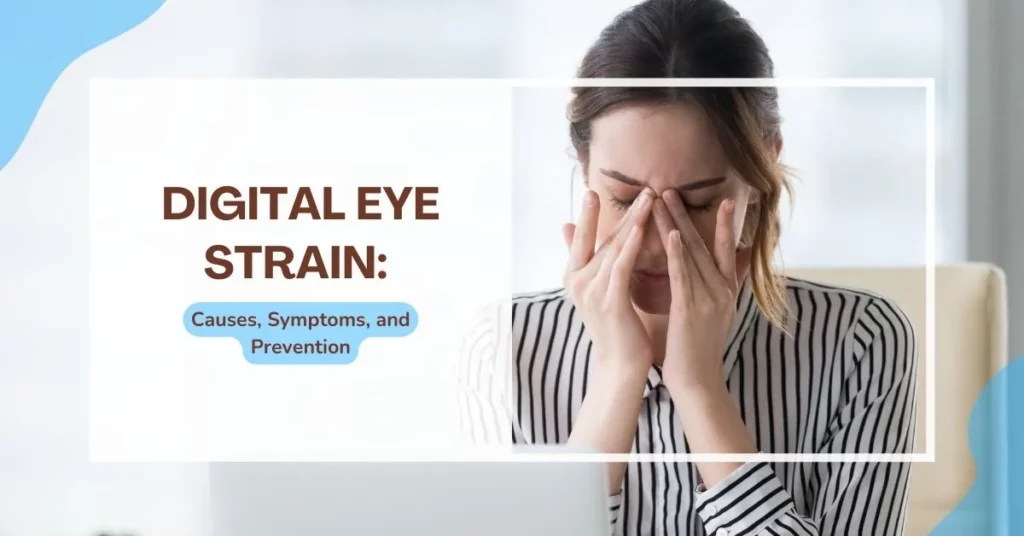Digital Eye Strain: Causes, Symptoms, and Prevention

Introduction:
In today’s digital age, many of us spend a significant amount of time in front of screens, whether for work, entertainment, or communication. However, prolonged screen use can lead to a condition known as digital eye strain. Also called computer vision syndrome, this condition causes a range of uncomfortable symptoms. This blog post will explore the causes, symptoms, and prevention strategies for digital eye strain.

Primary causes of Digital Eye Strain:
Digital eye strain occurs due to various factors associated with screen use:
- Extended Screen Time: Spending long hours staring at screens without breaks strains the eyes and the associated muscles.
- Blue Light Exposure: Screens emit blue light, which can contribute to eye fatigue and strain, disrupt sleep patterns, and potentially damage the retina over time.
- Poor Lighting Conditions: Insufficient lighting or excessive glare on screens forces the eyes to work harder to see clearly.
- Improper Viewing Distance: Sitting too close or far from the screen can strain the eyes as they constantly refocus to maintain clarity.

Digital eye strain manifests through a range of symptoms:
- Eye Discomfort: Dryness, redness, itching, and a gritty eye sensation are common symptoms of digital eye strain.
- Blurred Vision: Prolonged screen use can cause temporary blurred vision, making it quite challenging to focus on objects at different distances.
- Eye Fatigue and Strain: After prolonged screen exposure, eyes may feel tired, achy, or heavy.
- Headaches: Digital eye strain can cause headaches, especially from the forehead or temples.
- Neck and Shoulder Pain: Poor posture while using screens can lead to muscle strain in the neck and shoulders.

Prevention Strategies for Digital Eye Strain:
Fortunately, there are several preventive measures you can take to alleviate and minimize digital eye strain:
- Follow the 20-20-20 Rule: Every 20 minutes, take a 20-second break and look at an object 20 feet away. This helps relax eye muscles and reduce fatigue.
- Adjust Screen Settings: Optimize screen brightness, contrast, and font size to ensure comfortable viewing. Also, consider enabling night mode or blue light filters to reduce blue light exposure.
- Maintain Proper Viewing Distance and Position: Position your screen at an arm’s length distance and slightly below eye level to reduce strain on the eyes and neck.
- Improve Lighting: Avoid excessive glare by positioning your screen away from direct light sources. Opt for ambient lighting that is comfortable and evenly distributed.
- Blink Regularly: Remind yourself to blink frequently to keep the eyes moist and prevent dryness.
- Take Regular Screen Breaks: Incorporate short breaks into your screen time to give your eyes a rest. During holidays, focus on distant objects or perform eye exercises.
- Use Artificial Tears: If your eyes feel dry, consider using lubricating eye drops recommended by an eye care professional.
- Get Regular Eye Exams: Routine eye exams help detect and address any vision issues that may contribute to digital eye strain. Your eye care professional can also provide personalized advice and solutions.

Conclusion:
Digital eye strain is a common issue in our technology-driven world, but you can significantly reduce its impact by implementing simple preventive measures. Taking breaks, optimizing screen settings, maintaining proper viewing distance, and prioritizing eye health is essential in minimizing digital eye strain symptoms. Remember to consult an eye care professional for personalized guidance and to address any underlying vision issues. By practising healthy screen habits, you can protect your eyes and enjoy the benefits of technology without the discomfort of digital eye strain.
Book your appointment now for all eye-related services.
Your Vision Our Focus


